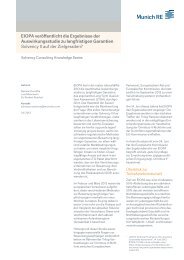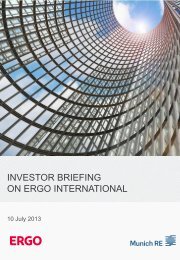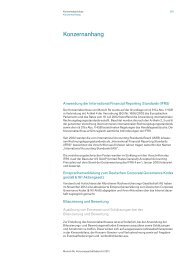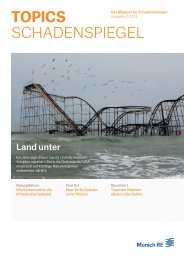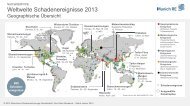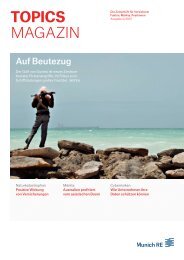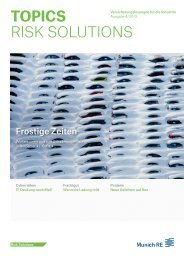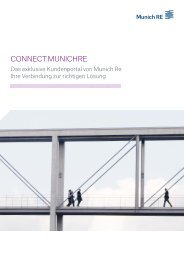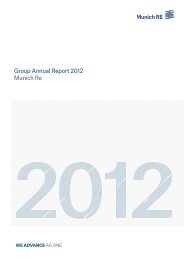Munich Re Group Annual Report 2006 (PDF, 1.8
Munich Re Group Annual Report 2006 (PDF, 1.8
Munich Re Group Annual Report 2006 (PDF, 1.8
Create successful ePaper yourself
Turn your PDF publications into a flip-book with our unique Google optimized e-Paper software.
<strong>Munich</strong> <strong>Re</strong> <strong>Group</strong> <strong>Annual</strong> <strong>Re</strong>port <strong>2006</strong> Management report_Financial situation<br />
exchangeable into Sanofi-Aventis shares were redeemed<br />
at their nominal value.<br />
The bank borrowing of ERGO AG shown in the previous<br />
year was repaid as planned. The other strategic debt<br />
was incurred to finance our operating activities in the long<br />
term.<br />
The interest expenses for strategic debt are shown<br />
separately in the consolidated income statement under<br />
“finance costs” and are explained in detail in the notes to<br />
the financial statements (see page 197 f.). As at 31 December<br />
<strong>2006</strong>, our debt leverage was 13.3%, down 4.5 percentage<br />
points on the previous year, due to a reduction in<br />
strategic debt and an increase in <strong>Group</strong> equity. There are<br />
currently no plans to increase strategic debt.<br />
Debt leverage<br />
31.12.<strong>2006</strong> Prev. year<br />
Strategic debt €m 4,059 5,277<br />
<strong>Group</strong> equity €m 26,429 24,397 *<br />
Total €m 30,488 29,674<br />
Debt leverage % 13.3 17.8<br />
* Adjusted owing to first-time application of IAS 19 (rev. 2004).<br />
If the own funds recognised under supervisory law are<br />
taken as the basis instead of the balance sheet equity, the<br />
strategic debt is reduced to €2,265m. This results in a debt<br />
leverage of 7.4%.<br />
<strong>Group</strong> solvency<br />
The <strong>Munich</strong> <strong>Re</strong> <strong>Group</strong> is subject not only to the supervisory<br />
requirements applying to individual insurance companies<br />
but also to supervision at <strong>Group</strong> level. <strong>Munich</strong> <strong>Re</strong>insurance<br />
Company as the parent has introduced suitable control<br />
methods, and its reports to the German Federal Financial<br />
Supervisory Authority (BaFin) responsible for the <strong>Munich</strong><br />
<strong>Re</strong> <strong>Group</strong> include supplementary aspects at <strong>Group</strong> level,<br />
such as shareholdings, consolidated financial data and<br />
intra-<strong>Group</strong> transactions. Solvency in the case of insurance<br />
companies is generally understood to be the ability of an<br />
insurer always to meet the obligations assumed under its<br />
contracts. This means an insurance company must fulfil<br />
specific minimum capital requirements. The aim of the<br />
“adjusted solvency” rules is to prevent the multiple use of<br />
equity to cover risks from underwriting business at different<br />
levels of the <strong>Group</strong> hierarchy. To calculate the adjusted<br />
solvency, the minimum equity required for the volume of<br />
business (required solvency margin) is compared with the<br />
eligible equity actually available (actual solvency margin)<br />
on the basis of the IFRS consolidated financial statements.<br />
In determining the eligible capital elements, the IFRS equity<br />
is adjusted; specifically, it is increased by portions of the<br />
subordinated liabilities and reduced by intangible assets.<br />
The <strong>Munich</strong> <strong>Re</strong> <strong>Group</strong>’s eligible capital is more than three<br />
times higher than the legal requirement.<br />
Adjusted solvency<br />
31.12.<strong>2006</strong> Prev. year<br />
Eligible capital of the <strong>Group</strong> €bn 24.8 22.9<br />
Adjusted solvency ratio % 345.2 305.7<br />
In <strong>2006</strong>, we modified the treatment of subordinated loans<br />
as own funds and have adjusted the previous year’s figures<br />
for ease of comparison. Thanks principally to the excellent<br />
<strong>Group</strong> result and the lower solvency requirements as a<br />
result of a reduced loss burden, the solvency ratio has continued<br />
to improve despite the share buy-back.<br />
All insurers in the <strong>Munich</strong> <strong>Re</strong> <strong>Group</strong> met the relevant<br />
solvency requirements in <strong>2006</strong>.<br />
Rating<br />
<strong>Munich</strong> <strong>Re</strong>’s financial strength is generally evaluated by<br />
the leading rating agencies as very positive, and our ratings<br />
remain at a high level. In December <strong>2006</strong>, Standard &<br />
Poor’s upgraded our rating from the third-best category,<br />
A+ (strong) to the second-best category, AA– (very strong)<br />
with a stable outlook. The reasons given by Standard &<br />
Poor’s for the upgrade are the sustained good operating<br />
performance, strong risk management, increased certainty<br />
about the adequacy of <strong>Munich</strong> <strong>Re</strong>’s reserves, and our<br />
strong competitive position, capitalisation and financial<br />
flexibility. Moody’s, A.M. Best and Fitch retained their good<br />
ratings from the previous year.<br />
Financial strength ratings for the <strong>Munich</strong> <strong>Re</strong> <strong>Group</strong><br />
Rating agency Rating Outlook<br />
A.M. Best A+ (Superior) Negative<br />
Fitch AA– (Very strong) Stable<br />
Moody’s Aa3 (Excellent) Stable<br />
Standard & Poor’s AA– (Very strong) Stable<br />
101



